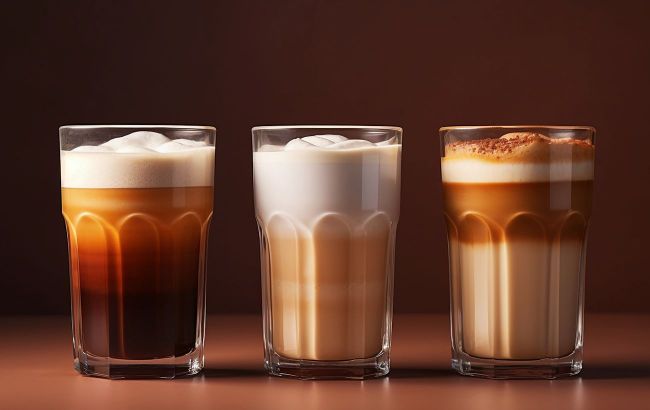Cappuccino vs. latte vs. macchiato - What’s the healthiest pick for your figure
 Which coffee is healthier — cappuccino, latte, or macchiato (photo: Freepik)
Which coffee is healthier — cappuccino, latte, or macchiato (photo: Freepik)
What are your favorite coffee drinks - cappuccino, latte, or macchiato - really hiding? All of them are based on espresso, whose health benefits are backed by science. However, some ingredients can drastically change their impact on your health and figure.
RBC-Ukraine, relying on scientific data and articles from reputable health sources, explains the key differences.
Espresso - a healthy base
First of all, it’s important to remember that coffee itself is a beneficial drink. Large-scale reviews of studies, such as one published in the British Medical Journal, link moderate coffee consumption (3–4 cups a day) with reduced risks of cardiovascular diseases, type 2 diabetes, liver diseases, and some cancers. This is due to its high antioxidant content, especially polyphenols.
So, the main difference in health benefits between cappuccino, latte, and macchiato isn’t in the coffee itself, but in what’s added to it.
Main factor - amount of milk
The key difference between these drinks is the proportion of milk, which directly affects calories, fat, and protein content.
Macchiato
Essentially, a shot of espresso with just a few drops of milk or milk foam. Because of the minimal milk, it’s the best choice for your figure. A standard serving contains only 10–15 kcal and retains nearly all the benefits of pure espresso.
Cappuccino
A balanced drink made of equal parts espresso, steamed milk, and milk foam. An average serving (about 350 ml) without sugar contains roughly 70–90 kcal. It’s the golden middle between strong coffee and creaminess.
Latte
Contains the most milk and the least foam. Because of this, it is the highest in calories among the three. An average serving (350–400 ml) without sugar may have 120–150 kcal or more, depending on the milk’s fat content.
Hidden threat: sugar and syrups
The greatest harm to health and figure comes not from milk, but from added sugar and sweet syrups.
As noted by health organizations such as the American Heart Association, excess sugar in the diet is a direct path to weight gain, metabolic disorders, and heart disease.
A large latte with vanilla or caramel syrup can contain 250–400 calories and 4–6 teaspoons of sugar, turning the coffee drink into a full-fledged liquid dessert.
What do scientific studies say?
A study published in the reputable medical journal JAMA Internal Medicine showed that people who drink coffee (up to 5 cups a day) have a lower risk of premature death.
It is important that the study mostly analyzed black coffee. Adding milk does not negate the benefits of antioxidants in coffee, but it significantly increases the calorie content.
So which drink to choose: cappuccino, latte, or macchiato?
For maximum benefits and minimum calories, choose a macchiato. It is closest to pure espresso.
For a balanced taste, unsweetened cappuccino is a great compromise. You get a pleasant milky texture but fewer calories than in a latte.
If you love the milky taste, then choose a latte, but ask for it to be made with skimmed or plant-based milk (almond, coconut), and most importantly, avoid sugar and syrups.
The general rule is simple: the healthiest coffee is the one with the fewest additives.
You might be interested in:
This material is for informational purposes only and should not be used for medical diagnosis or self-treatment. Our goal is to provide readers with accurate information about symptoms, causes, and methods of detecting diseases. RBС-Ukraine is not responsible for any diagnoses that readers may make based on materials from the resource. We do not recommend self-treatment and advise consulting a doctor in case of any health concerns.

